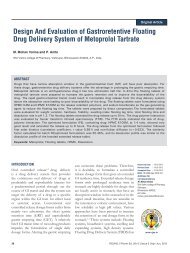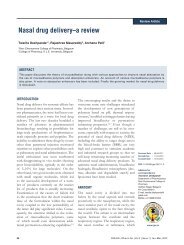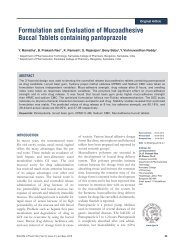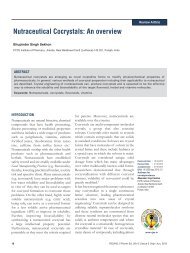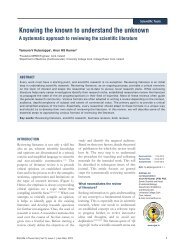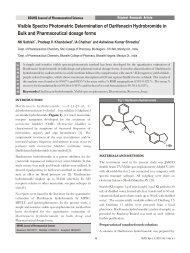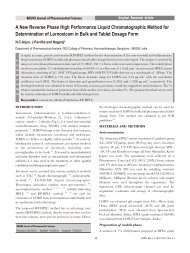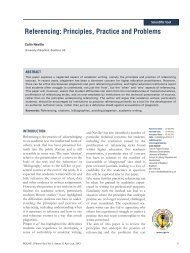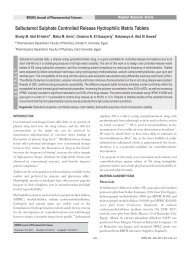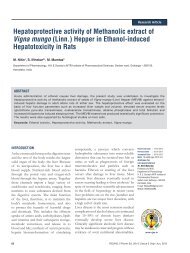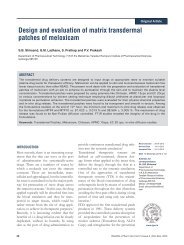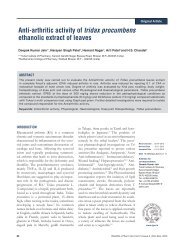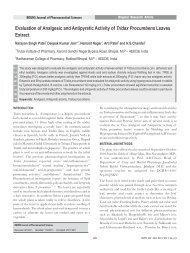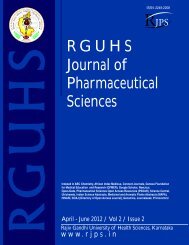Chitosan Loaded Mucoadhesive Microspheres of Gliclazide - Journal
Chitosan Loaded Mucoadhesive Microspheres of Gliclazide - Journal
Chitosan Loaded Mucoadhesive Microspheres of Gliclazide - Journal
You also want an ePaper? Increase the reach of your titles
YUMPU automatically turns print PDFs into web optimized ePapers that Google loves.
14<br />
Thanoo et al . Twenty preliminary trial batches (F1 to F20)<br />
were prepared, 1.5 gm <strong>of</strong> Polymer was dissolved in 150 mL <strong>of</strong><br />
1% v/v aqueous acetic acid solution and 500 mg <strong>of</strong> drug was<br />
dispersed in the polymer solution. The resulting mixture was<br />
extruded through a syringe (No. 20) in 1 L <strong>of</strong> liquid paraffin<br />
heavy and light (1:1 ratio) containing 0.2% dioctyl sodium<br />
sulfosuccinate. The stirring was performed using a propeller<br />
stirrer 1000 rpm at constant for all the batches. After 15<br />
minutes, glutaraldehyde was added and stirring was<br />
continued. The amount <strong>of</strong> glutaraldehyde and cross linking<br />
time was found varying for all the batches. On the basis <strong>of</strong> the<br />
2<br />
preliminary trials 3 full factorial designs were employed. The<br />
polymer-to-drug ratio (1:1, 3:1 and 6:1) and stirring speed<br />
(500, 1000 and 1500 rpm) were varied in all the nine factorial<br />
design batches. All other variables were used as mentioned in<br />
preliminary trial batches. <strong>Microspheres</strong> thus obtained were<br />
filtered and washed several time with petroleum ether (80:20)<br />
to remove traces <strong>of</strong> oil. They were finally washed with water to<br />
remove excess <strong>of</strong> glutaraldehyde. The microspheres were<br />
then dried at 25°C and 60% RH for 24 hours.<br />
Evaluation <strong>of</strong> <strong>Microspheres</strong><br />
Drug Content<br />
According to literature review the assay for gliclazide was<br />
estimated by uv spectrophotometric method. Aqueous<br />
solution <strong>of</strong> drug was prepared in phosphate buffer (pH 6.8)<br />
and absorbance was measured on uv spectrophotometer at<br />
229 nm the method is validated for linearity, accuracy and<br />
22<br />
precision . The method obeys Beer's law in the concentration<br />
range <strong>of</strong> 5 to 50 mµg/mL, a standard drug solution was<br />
analyzed repeatedly, the accuracy and precision were<br />
determined.<br />
Drug Entrapment Efficiency<br />
50 mg <strong>of</strong> microspheres were crushed in a glass mortar and<br />
pestle, and the powdered microspheres was suspend in 10 mL<br />
<strong>of</strong> phosphate buffer solution (pH 6.8). After 24 hours, the<br />
solution filtered and the filtrate was analyzed for the drug<br />
content. The drug entrapment efficiency was calculated using<br />
the following formula; Practical drug content / Theoretical<br />
drug content x 100.<br />
Surface Morphology<br />
Surface morphology <strong>of</strong> the microspheres was determined by<br />
using scanning electron photomicrograph.<br />
Particle Size<br />
A Senthil et al./ <strong>Chitosan</strong> <strong>Loaded</strong> <strong>Mucoadhesive</strong> <strong>Microspheres</strong> <strong>of</strong> <strong>Gliclazide</strong>: In vtro and In vivo Evaluation<br />
The particle size <strong>of</strong> the microspheres was determined by using<br />
23<br />
optical microscopy method .<br />
164<br />
Swelling Index<br />
The swelling ability <strong>of</strong> microspheres in physiological media<br />
was determined by optical microscopy method. The 100<br />
microspheres were suspended in 5 mL <strong>of</strong> stimulated gastric<br />
fluid USP (pH 1.2). The particle size was monitored by<br />
microscopy technique every 1 hour up to 8 hours using an<br />
25<br />
optical microscope .<br />
In vitro Wash-<strong>of</strong>f Test for <strong>Microspheres</strong><br />
A rat stomach mucosa was tied onto a glass slide (3 inch by 1<br />
inch) using thread. <strong>Microspheres</strong> were spread onto the wet<br />
rinsed tissue specimen, and the prepared slide was hung onto<br />
one <strong>of</strong> the groves <strong>of</strong> a USP tablet disintegrating test apparatus<br />
containing the simulated gastric fluid (pH 1.2). The<br />
disintegrating test apparatus were operated such that the<br />
tissue specimen was given regular up and down movements.<br />
At the end <strong>of</strong> 30 minutes, 1 hour, and at hourly intervals up to<br />
10 hours, the number <strong>of</strong> microspheres still adhering onto the<br />
26<br />
tissue was counted .<br />
Drug release Study<br />
The drug release study will perform using USP XXIV basket<br />
apparatus at 37°C±0.5°C and 100 rpm using 900 mL <strong>of</strong><br />
phosphate buffer (pH 6.8) as dissolution medium.<br />
<strong>Microspheres</strong> equivalent to 10 mg <strong>of</strong> gliclazide were used for<br />
the test. Sample 5 mL was withdrawn at predetermined time<br />
intervals and filtered through a 0.45 micron membrane filter,<br />
diluted suitably and analyzed. Percentage drug dissolved at<br />
different time intervals was calculated using the Lamberts-<br />
27<br />
Beer's law equation .<br />
Release Kinetics and Mechanism<br />
To know the release mechanism and kinetics <strong>of</strong> gliclazide,<br />
optimized formulation was attempted to fit in to<br />
2<br />
mathematical models and n, r values for zero order, first<br />
order, higuchi and peppas models.<br />
Factorial Design<br />
A statistical model incorporating interactive and polynomial<br />
terms was utilized to evaluate the responses.<br />
2 2<br />
Y=b 0+b1X 1+b2X 2+b12X1X 2+b11X 1 +b22X2 Where, Y is the dependent variable, b 0 is the arithmetic mean<br />
response <strong>of</strong> the nine runs, and b 1 is the estimated coefficient<br />
for the factor X 1. The main effects (X 1 and X 2)<br />
represent the<br />
average result <strong>of</strong> changing one factor at a time from its low to<br />
high value. The interaction terms (X 1 X 2)<br />
show how the<br />
response changes when two factors are simultaneously<br />
2 2<br />
changed. The polynomial terms (X 1 and X 2 ) are included to<br />
investigate non-linearity. On the basis <strong>of</strong> the preliminary trials<br />
RJPS, Jul - Sep, 2011/ Vol 1/ Issue 2



